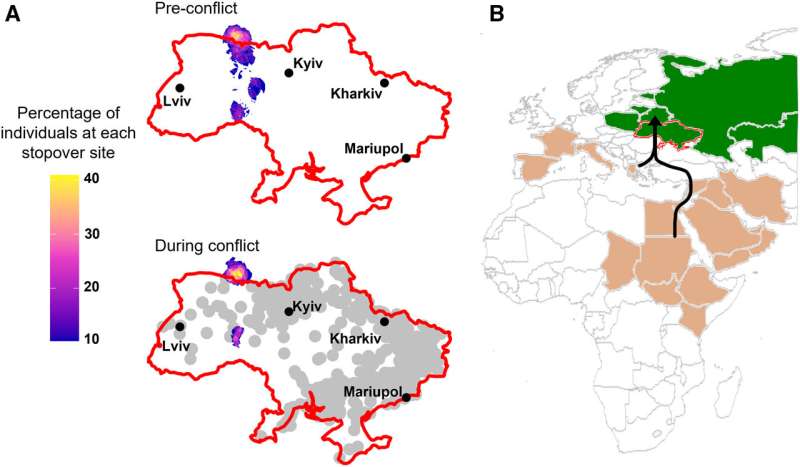This article has been reviewed according to Science X's editorial process and policies. Editors have highlighted the following attributes while ensuring the content's credibility:
fact-checked
peer-reviewed publication
trusted source
proofread
Endangered migrating eagles impacted by Ukraine war, new study shows

A new study reveals for the first time the impact of ongoing conflicts on the migration of an endangered bird species. The paper "Active European Warzone Impacts Raptor Migration" was published in Current Biology on May 20.
Researchers from the University of East Anglia (UEA), the British Trust for Ornithology (BTO) and the Estonian University of Life Sciences compared the movement and migration of the Greater Spotted Eagle through Ukraine, before and shortly after it was invaded by Russia in February 2022.
They were already studying the species when the war started, with the dangers faced by migratory birds usually related to disruptive weather or drought, changes in land use affecting traditional stopping-off points, or destruction of essential habitats.
However, during the invasion the team found that the eagles, which had previously been fitted with GPS tracking devices, were exposed to multiple conflict events along their journey through the country in March and April.
These included artillery fire, jets, tanks and other weaponry, as well as unprecedented numbers of soldiers moving through the landscape and millions of civilians displaced.
Their migratory behavior, gathered from the tracking data, was compared to previous years as they passed between wintering areas in southern Europe and East Africa and key breeding grounds in southern Belarus.
The findings reveal the eagles made large deviations from their traditional migratory routes. They also spent less time stopping at their usual refueling sites in Ukraine or avoided them entirely.
This resulted in the eagles traveling further and arriving on their nesting grounds later than usual. This could seriously affect them and likely contributed to reduced physical fitness at a time when peak condition is critical to successful breeding.
The researchers say the findings show the potentially wide-ranging impacts of conflicts on wildlife, which is important as many biodiversity hotspots are in politically volatile countries.
The study's lead author Charlie Russell, a postgraduate researcher in the School of Environmental Sciences at UEA, said, "The war in Ukraine has had a devastating impact on people and the environment. Our findings provide a rare window into how conflicts affect wildlife, improving our understanding of the potential impacts of exposure to such events or other extreme human activities that are difficult to predict or monitor.
"These types of disturbances can have significant impacts on the behavior, and potentially fitness of the eagles. For individuals breeding in these areas, or other species that are less able to respond to disturbance, the impacts are likely to be much greater."
"Our findings show how human disturbance can inadvertently impact wildlife," said Dr. Adham Ashton-Butt, Senior Research Ecologist with BTO.
"Migratory birds such as Greater Spotted Eagles are drastically declining all over the world and it's imperative that we better understand and mitigate our effects on these charismatic species."
By early March 2022, when the first of 19 GPS-tagged eagles entered Ukraine on their way north, the war had spread to most major cities, exposing them to areas of intense human conflict.
The team found the birds flew further and less directly to breeding grounds, traveling an extra 85km on average. Migrations also took longer: 246 hours compared to 193 pre-conflict for females, and 181 hours compared to 125 pre-conflict for males. Males also traveled more slowly than in the years before the war.
Fewer birds stopped in Ukraine before returning to their breeding grounds, with just six out of 19 (30%) making stopovers, compared to 18 out of 20 (90%) in 2018–2021, while some important stopover sites, for example in Ukrainian Polesia, were not used at all in 2022.
The researchers suggest differences across sexes in flight speed may correspond with migration strategies, with males making longer journeys from wintering grounds in eastern Africa before reaching Ukraine, compared to females migrating from Greece. This could also impact breeding success if a disproportionate number of either sex is heavily affected by events linked to the war.
Co-author Dr. Aldina Franco, from UEA, develops technologies for animal tracking. She added, "Remote tracking of wildlife enables researchers to understand the impact of human activities, such as hunting or energy infrastructure, on the environment and wildlife populations. In this case, it is providing insights on how armed conflict events impact animal behavior and migration.
"Collecting this data is limited by the logistical implications of working in these areas and previous research has been limited to resident birds in military training zones. However, our tracking data gives us a unique window into how migrating eagles experience and respond to intense conflict."
More information: Charlie Russell et al, Active European Warzone Impacts Raptor Migration, Current Biology (2024). DOI: 10.1016/j.cub.2024.04.047. www.cell.com/current-biology/f … 0960-9822(24)00519-0
Journal information: Current Biology
Provided by University of East Anglia



















